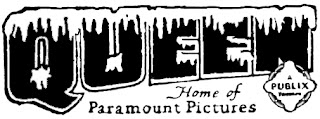From Robert Runyon panoramic photograph ca.1916
The
Queen Theater first opened on February 19, 1916 at 1107 Elizabeth St. across
the alley behind the Dittmann Theater.
Its owner was Andrew Pappas who had recently opened the Manhattan Café
next door in the same building. Mike
Manahan owned the Billiard Academy on the second floor. It included a gymnasium, showers and tables
for dominoes. The Queen had a seating
capacity of three hundred, two projectors for continuous operation and the most
expensive screen south of Houston. Its
screen was made of gold fiber and cost seventy-five dollars. Pappas had contracts with Paramount, William
K. Fox and Mutual Masters to show films from their distributors.
Close-up showing Manhatten Cafe and Billiards room with Theater
Saborn map used to show locations of theaters in 1919
1916 Queen Theater photo. Admission was 13¢ ~ Box seat 23¢ and Children 5¢. In addition to playing billiards you could use the gymnasium and have a bath afterward (for a few pennies maybe). Written on back "Modern Theather (sic) at Brownsville, Texas - Photo taken by a soldier of the 3rd Iowa NG"
It opened with the Charlie Chaplin classic,
“Tillie’s Punctured Romance” and showed films between 1 p.m. and 11 p.m. By 1919 Ira G. Keeler was its owner.
1916 Googled images
In
June 1919, managers of the three principal theaters (The Dittmann, Dreamland
and Queen) were summoned by a new board of censors appointed by Mayor A.A.
Browne to address concerns regarding the exhibition of films with objectionable
content. Films that stirred controversy
included unsavory type casts of Mexican characters. The board stressed that living on a border
town where citizens of two nations meet and amicably exist was no place to stir
up resentment. All three managers were
in agreement and invited censor committee members to pre-screenings of films they
suspected might be objectionable.
1926 Sanborn maps showing locations of these theaters downtown
A decade
after the Queen first appeared; it reopened in a new building on Elizabeth St.
next to First National Bank on the corner of 12th St. in 1926.
1926 February 3rd Brownsville Herald First page
The building space vacated by the original
Queen became the Texas Theater owned by the Delta Amusement Co who later built
the Capitol in 1928.
Ed Brady, a well
known theater pioneer from San Benito, bought ownership of the Queen from A.
Orive and partnered with Paco Betancourt to manage the new Queen.
Edelstein’s of Brownsville, a long
established furniture store chain of the Rio Grande delta, supplied furnishings
and draperies from its new drapery department.
Brady also purchased a pipe organ for $7,500 and a large screen from the
Simplex Theater Supply Co. of Dallas.
The Queen Barber shop also opened in the building. By April 1928, The Capitol, Queen and Texas
theaters became incorporated into the Brownsville Amusement Company made up of
John C. Fanning, Paco Betancourt, Ed F. Brady and Brown White.
1930 Sanborn map section
1940s Bill Stevenson and Francis Cowan in front of Queen Theatre - Cowans father had cigar store there -- Thank to Dale Stevenson for sharing this with us
Five
glass chandeliers hung from the ceiling and smaller lights lined the
walls. The 25 x 50 ft stage was large
enough for vaudeville shows.
1933 photo from brochure from Rod Bates Collection ~ Port Isabel
The
screen was 16 x 20 ft. and it had a seating capacity of 750; 550 on the first level with 200 seat up on
the upper gallery seats (balcony seats).
There was also a “pit” for musicians to play music to match the momentum
of the action or mood of the films shown there.
The two projectors came from the previous theater as they had only been
purchased a month beforehand while the “new” Queen was being built so no time
would be lost in the transition.
The
Queen’s upright lighted sign was badly damaged by a hurricane in 1933. After
the hurricane, The Capitol sponsored a benefit for storm victims to raise funds
for local relief agencies. In later
years, several local theaters became sanctuaries for public citizens needing
safe shelter from major storms.
1933 hurricane damage to sign (photo Brownsville Heritage Museum)
Jesus “Chuy” Abete grew up in the late '40s and worked many theaters and drive-ins beginning with the Fiesta in 1954. He came from the Abete family which we hope to revisit with a future post. Mr Abete recalled as a boy how many cowboy western movie stars had taken their horse on stage and dance around and met local fans at a time when movie stars would stay at El Jardin Hotel and also perform at the Capitol Theater in later years.
1938 ad ~ Johnny Mack Brown is was one of the cowboys Jesus Abete mentioned when I interviewed him years ago. He is still alive and well as of this writing and can be seen with his colorful wooden lawn and garden ornamnents and fixtures at the Mittie Cultural Park "Farmers Market" on Saturdays.
Tell me you remember Leo Carrillo from the Cisco Kid reruns and I'll know I'm not alone. He might have visited Brownsville too. This postcard is from 1941.
1942 Arthur Rothstein photo taken during Charro Days
1960 Palmetto yearbook
No other information at this time but the Queen's demise came after the Capitol, Grande and Majestic Theaters showed newer movies and sold more tickets. Before the advent of television, video and cable tv movies could enjoy a third or fourth run if people were willing to se it at reduced ticket costs.
From corner of former bank building at 12th and E Elizabeth St ~ photo 2005 Javier R. Garcia)
photo 2005 (Javier R. Garcia)




































































